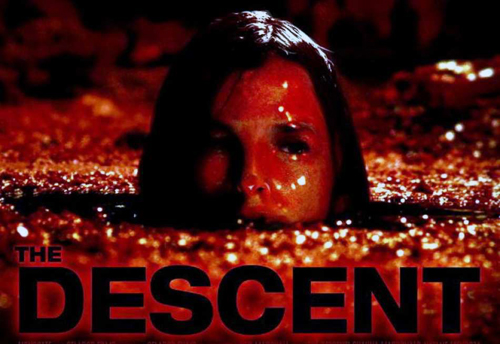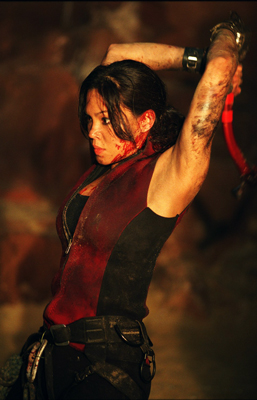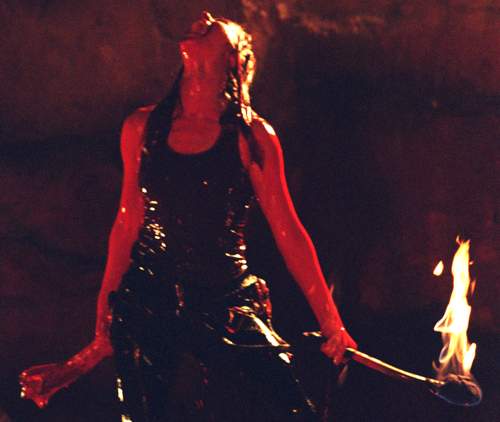Walking Up and Down in the Earth
Thursday, August 17, 2006
posted by Steve Tompkins
 Print This Post
Print This Post
No getting around it; cinematic sword-and-sorcery is a world of suck. Definitional elasticity is desperately needed so that we can claim artistic successes like John Boorman’s Excalibur, John McTiernan’s The Thirteenth Warrior, and Peter Jackson’s The Two Towers for a subgenre to which they don’t incontrovertibly belong. Hell, George Miller’s The Road Warrior and Michael Mann’s The Last of the Mohicans capture more of the feel and frisson of the best sword-and-sorcery (recall the Mann movie’s endgame of inevitable, almost Iliad-ic death-duels against an impossibly dramatic backdrop with a soundtrack that is all Celtic keening and skirling) than does anything ever dumbed down and screwed up by a member of the De Laurentiis family.
So heroic fantasy aficionados usually have to settle for table-scraps and objets trouvés, an extended sequence here or the better part of a Chronicles of Riddick there. Case in point: the 2 tentacular spectaculars of kraken-on-ship action in this summer’s Dead Man’s Chest, prodigies of special effects, editing, and stuntwork, like Jackson’s Kong-versus-three-tyrannosaurs tour de force last Christmas. Davey Jones’ kraken dragging down its tall-masted prey is probably as close as we’ll ever get to the Oraycha setpieces of Karl Edward Wagner’s sorcery-and-superscience-permeated sea battle in Darkness Weaves.

This week I was thrilled to see the second hour of Neil Marshall’s horror film The Descent devolve into screaming, gore-drenched, civilization-is-a-whim-of-circumstance sword-and-sorcery. Marshall put himself on the map with 2002’s Dog Soldiers, in which a British infantry squad that has already drawn the booby prize of playing the Washington Generals to the Harlem Globetrotters of elite SAS commandos during maneuvers in the Scottish Highlands winds up being hunted through the woods and besieged in a farmhouse by local lycanthropes. Dog Soldiers easily transcends having been filmed on a wing, a prayer, and no more than a fistful of credit cards, and given its setting, offers the Howard-minded what could almost be a Sassenach nightmare of ferocious primitivism on the part of untamed clansmen. In The Descent, sinewy spelunker sportswomen explore a “new” Appalachian cave system, and I for one was unnerved long before the sonar-gifted, troglodytic cavespawn showed up. I never get tired of surface-dwelling, find non-entombment exhilarating, and prefer that there not be tons of rock and dirt between me and the open air; just seeing the name Hugh B. Cave is enough to start me sweating.
The Descent dances on the grave of last year’s similarly-themed, ineptly-executed The Cave and could almost be a more visceral and hyperkinetic version of Karl Edward Wagner’s classic “.220 Swift.” (If you don’t own the KEW collection In a Lonely Place, which assembles “.220 Swift” and seven other stories, get thee to Addall.com forthwith) Marshall’s protagonists don’t take kindly to being devoured while still alive and kicking; despite what Jim Charles would deem an appalling absence of guns and with their flares, headlamps, and glow-sticks as quickly extinguished as their hope of escape, they channel their inner Ripleys and Sarah Connors and do staggering amounts of damage with caver’s-tools-turned-edged-weapons. Peter Hartlaub of the San Francisco Chronicle was moved to ask “Do we even need men in horror films anymore?. . .They don’t look as good covered in sweat and blood.” Preach it, brother; while banning men altogether might be excessive, the unfashionability of yesteryear’s ankle-clingers and cringe-behinders is one of the saving graces of present-day popular culture. In particular Juno, the alpha female powerfully and beautifully embodied by an actress named Natalie Mendoza, is a fascinating variation on the Burt Reynolds character in Deliverance.

The cave paintings discovered by Juno and her friends early on hint that Marshall’s lurkers might be the descendants of native Americans even more native than the native Americans we think we know, another link to “.220 Swift,” which was itself a kind of homegrown “Worms of the Earth” or “Valley of the Lost” for Wagner:
Deep within the earth, fortress cities were shaken and smashed by the Hell that reigned miles above. From out of the ruins, survivors crept to attempt to salvage some of the wonders of the age that had died and left them exiles in a strange world. Darkness and savagery stole from them their ideals, even as monstrous dwellers from even greater depths of the earth drove them from their buried cities and upward through caverns that opened onto an alien surface. In the silent halls of vanished greatness, nightmarish shapes crawled like maggots, while the knowledge of that godlike age was a fading memory to the degenerate descendants of those who had fled.
As KEW told it in the afterword to In a Lonely Place, “In the summer of 1969 I lived in a cabin in Haywood County, North Carolina while working in a medical clinic there. The cabin and mountain settings are those in which I was living during this time. The legends of the Lost Mines of the Ancients, as described in ‘.220 Swift,’ are not pseudohistory as one critic suggested, but are historical fact — or mystery.” Interestingly, “Two Suns Setting,” one of Wagner’s best Kane stories, also deals with being trapped underground with something that is infinitely better adapted to subterranean survival. Reporting on his experiences to a topsider in “.220 Swift,” a character laconically but hauntingly says “I’ve been walking up and down in the earth.” With The Descent, Neil Marshall has become a new poet goreate of that activity at its most frenzied.

